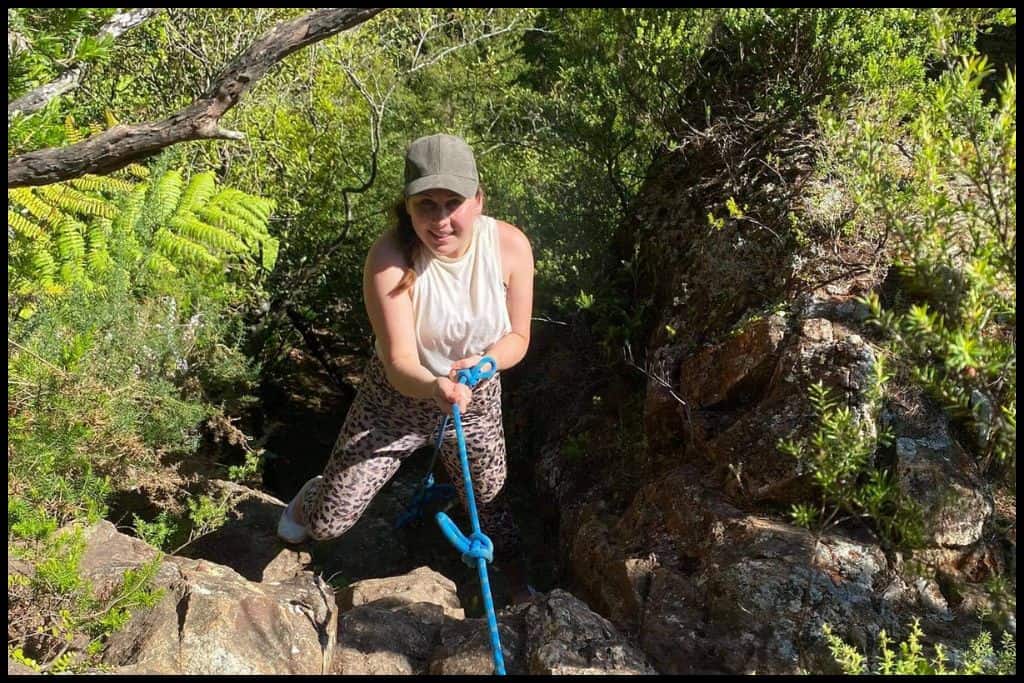New Zealand In Summer: 15 Best Things To Do & Where To Go

Deciding when to come to New Zealand? Summer is a winner all-round, for sure.
Summer coincides with our holiday break over Christmas and New Year, and the holiday season continues right through to February, so while it is our busiest time for domestic travellers, it is also the time of our best weather, which means it is a great time to explore our beautiful outdoors in comfort. February is a fantastic month to travel around, as many people have returned to work and school, but the weather is still fabulous.
New Zealand is lucky to have lots of fantastic landscapes – from our mountains and rivers, forests and bush, lakes and glaciers, rolling farmland and glittering coastlines. When the weather is good, it is the perfect time to head out there for hiking, fishing, cycling, kayaking and swimming. There are also so many festivals happening all over the place, and gardens, vineyards, orchards and trails galore to explore.
New Zealand In Summer
First things first: when is our New Zealand summer? Our summer months are December, January and February. November can still be a little rainy in parts as spring wraps up, and most of us go on holiday in December and January. January and February are our hottest months, and many places enjoy really stable weather as summer comes to a close and autumn sets in.
Personally, my favourite month in New Zealand is March, so even if you come a little later, you are unlikely to be disappointed. The weather is often clear and crisp, and the South Island especially has wonderful autumns. Many of our activities can still be enjoyed, and in our hiking group, it’s a favourite time to go hiking, as the weather is not quite so hot.
What Is The Weather Like In New Zealand In Summer?
Our weather is not always guaranteed, and sometimes summer gets some wet spells. Auckland has had wet Christmas periods for several years now, and the West Coast of the South Island can get rain any time. Milford Sound in the southwest of the South Island is also notorious for wet weather, so come managing your expectations.
Generally, however, New Zealand enjoys hot and fine summers, with some of the more tropical weather being up in the Northland region. The hottest part of the country each summer is Central Otago, where summer temperatures will almost certainly be in the thirties (77+°C). (Many other destinations will reach the high twenties but max out at around 30°C, which is 77°F to 86°F.) Auckland has high humidity, while Otago and Canterbury regions in particular get dry heat.
Being in the Southern Hemisphere, the hotter parts are generally those further north – but Central Otago really gets hit with the heat because of how inland it is, because of it’s its terrain, and something called a rain shadow.
February is New Zealand’s hottest month. Beach destinations like the Bay of Islands and the Coromandel Peninsula sit between 17°C to 24°C (which is 63°F to 75°F). Our most populous city, Auckland, generally experiences temperatures of 16°C to 24°C at its hottest (which is 61°F to 75°F). The East Coast of the South Island can sit between 12°C to 30°C (which is 54°F to 86°F) and dry, rocky, Central Otago can sit between 10°C to 30°C (which is 50°F to 86°F).
15 Best Things To Do In New Zealand In Summer
We have endless activities that are best enjoyed during the summer, because of how great the outdoors are here. Here are my top 15 summer activities to add to your bucket list, that I would consider to be best enjoyed over summer.
1. Go for a paddle in a sea kayak
When the warm weather hits, out on the water is a great place to be. We have 15,000 kilometres (9,300 miles) of coastline in New Zealand, so endless, endless beaches. Some spots are especially great for a spot of sea kayaking – the best place of all would be Abel Tasman National Park.
This national park is located at the top of the South Island and enjoys a lot of sheltered waters, lots of little bays, coves and inlets, and some truly beautiful beaches. The waters are so clear and you’ll even perhaps spot a seal or two swimming next to you!
There are lots of operators in the area from whom you can hire a sea kayak. You can hire for a range of hours or days – there are lots of different packages to suit. An efficient water taxi service runs between all the bays so transport is no issue here. There are lots of campsites near the shores, also used by the hikers undertaking the Abel Tasman Coastal Track, so this is a perfectly customisable little holiday!
➡️ xx

2. Hit the beach for some time in the sun, sea and sand
With our 15,000 kilometres (9,300 miles) of coastline in New Zealand, it’s not hard to find a good beach for spending a summer’s day. Some are calm and great for paddleboarding or swimming with littlies, and some have great surf.
A popular pasttime for New Zealanders in summer is boogie-boarding, so if you can get hold of one, head out into the surf with one and enjoy the waves! Any patrolled surf beach in New Zealand has red and yellow flags set up by the lifeguards to denote the safe places to swim, away from rips and currents, so it’s really important to stay between the flags for your safety.
Patches outside the flags might look calm but may have invisible currents and undertows under the surface that will you pull out to sea. Our lifeguards are volunteers stationed at all our popular beaches and are actively looking out for swimmers, but being in between the flags is the best thing you can do for a safe and fun day out.
New Zealand is situated under a hole in the earth’s ozone layer, and this means that you will burn quickly if you do not take sunsafe measures. In other parts of the world you can sunbathe for longer before burning, if at all, but in New Zealand you have ten minutes, so always be vigilant applying suncream and get as high of an SPF (sun protection factor) as you can.
A sunscreen with 20SPF means that you can last twenty times longer out there (twenty x ten minutes) before burning – but being in and out of the water affects this too.
➡️ xx
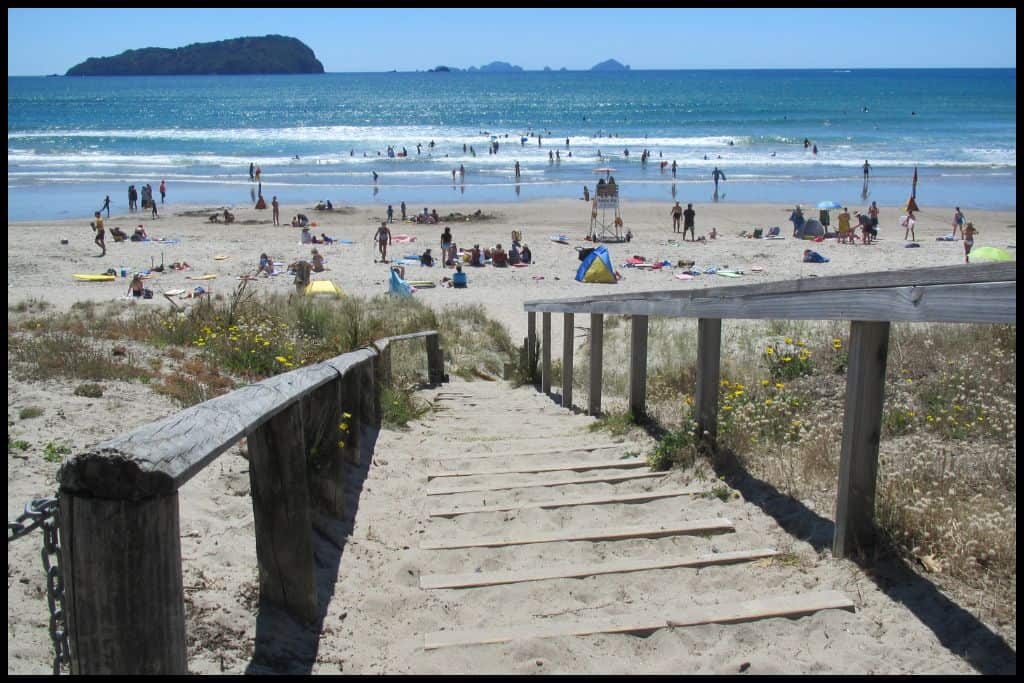
3. Encounter some of our marine life
A great time to have an encounter with our marine life is during summer, when you aren’t going to freeze in the water! Marlborough, Akaroa and Kaikōura are awesome spots for getting in the water with dolphins – Akaroa especially, because this is the only place in the world where you can have an up close encounter with a Hector’s dolphin.
Hector’s dolphins are the world’s smallest dolphin, and they’re only found in New Zealand. They’re endangered, so going out with an operator (and there are several) is the best way to ensure the safety of the species – and yours, too.
There are also swimming with seal experiences in Kaikōura.
If you’re holidaying in the North Island, dolphin swims are also available in Tauranga, in the Bay of Plenty region, and in the Bay of Islands, in Northland region.
As for whales? In New Zealand, you’re best to encounter them from a boat or plane. (The nation of Tonga is perhaps the closest place where swimming with whales happens.)
If you just want to see little fish, we’ve got some great marine reserves where you can go snorkelling! Best places would be Goat Island Marine Reserve just north of Auckland City, Poor Knights Islands Marine Reserve, a little further north, or Cathedral Cove Marine Reserve out on the Coromandel Peninsula in Waikato region.
➡️ xx

4. Admire rows upon rows of sunflowers
New Zealand has several sunflower farms – most fairly new places that have started popping up – and summer is the ideal time to enjoy the blooms.
I have personally been to the Taupiri Sunflower Farm, which is in the Waikato region (but not too far along once you’ve exited south out of Auckland), which is where I had my maternity shoot. Also near Hamilton City is Kaipaki Sunfowers. Franklin Farm also operates just north of Auckland City in Waimauku. In Karaka, South Auckland, we now have Sunshine Fields, and Cedel Downs in Taupaki, West Auckland, so there’s plenty of options if you’re in our biggest city for the summer.
In the Manawatu District, just out of Palmerston North (two thirds of the way down the North Island), is Mangamaire Sunflower Farm, and Hiwinui Sunflower Field and Newbury Sunflowers are even closer still to the city of Palmerston North. And over in Hawkes Bay is Baxter’s Sunflower Farm.
In the South Island, you have South Eyre Sunflowers, inland from Christchurch city, and Christchurch Sunflower Farm, which is really just on the city outskirts. And then down in Central Otago district is Earnscleugh, where you have Roberts Family Café and their masses of sunflowers, and Kakanui Sunflowers, out toward Oamaru on the coast, in the Waitaki district.
➡️ xx
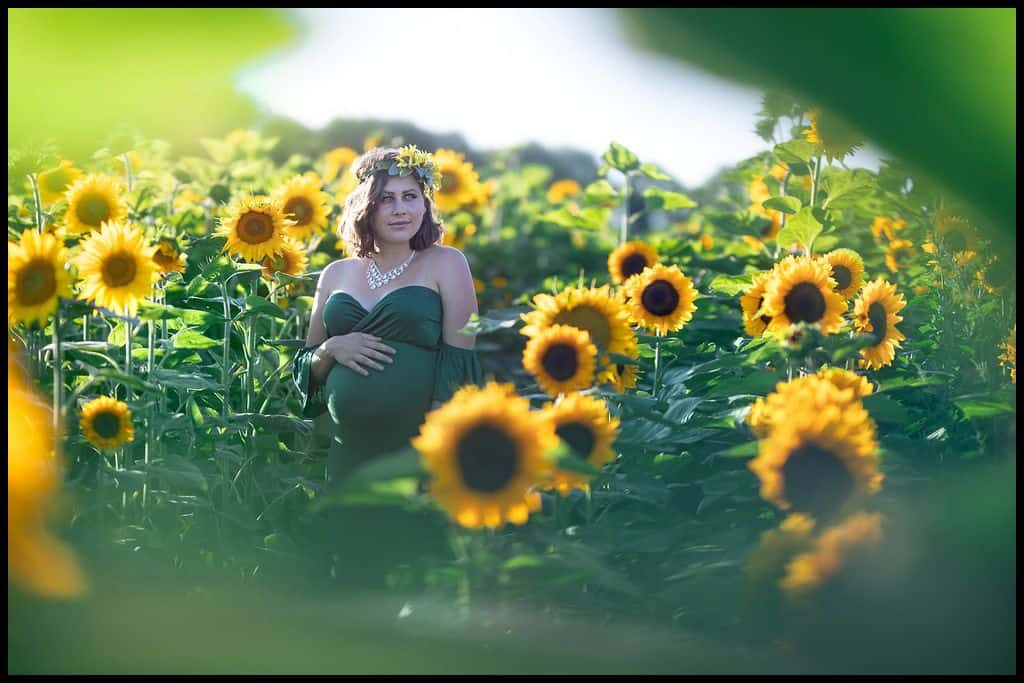
5. Breathe in deep at one of our beautiful lavender farms
Summer is also a fabulous time to visit a lavender farm – and we have several!
Northernmost we have CCT Lavender in Karaka in the south of Auckland City, and Lavender Backyard Garden in Hamilton City, in the Waikato region. Alphra Lavender in Te Awamutu is not far away.
Down in the Manawatu-Whanganui region, along the Forgotten World Highway, lies Lauren’s Lavender Farm, but you’ve also got Apiti Lavender Farm, closer to Feilding, too. The Hawkes Bay region has Casa Lavanda and Nevaria Lavender, which is in Napier.
Further south in the Wairarapa in the bottom right hand corner of the North Island is Ranui Essentials Lavender Farm, and Lavender Magic, nearby in Carterton.
Across the strait lies Moutere Lavender Company in the Tasman region, Marlborough Lavender Estate, and Lavendyl Kaikoura Lavender Farm a little more south of there, on the east coast of the South Island. North of Christchurch City in Waikuku is Lavender Fields, with Akaroa Lavender out on Banks Peninsula, halfway down the east coast.
New Zealand Alpine Lavender sits right under Mount Cook, in the middle of the Southern Alps, and further down in Otago region you have Wanaka Lavender Farm in Wanaka and Ben Lomond Lavender on the outskirts of Queenstown. Central Otago has Bunny Lane Lavender and Lavender Row is on the outskirts of Dunedin City.
Many of these estates let you wander amongst the flowers, some will let you pick your own, and nearly all have gift shops where you can find something lovely to take home. A perfect summer’s afternoon out.
➡️ xx

6. Capture the end of the season for our famous lupins
People from all over the world make a pilgrimage to New Zealand each spring/summer for the instagram-famous alpine lupins, the pink and purple blooms (actually weeds!) that line the shorelines of some of our glacial lakes and rivers.
The bloom starts in the middle of November, although it is a little dependent on how far north or south the lupins are, and will stretch into January, but December is the best time to see these beautifully coloured shorelines.
Generally, our lupins are found in and around Mount Cook in the Southern Alps, Lake Pukaki and Lake Tekapo in the Mackenzie Basin, part of Aoraki Mount Cook National Park, and further south in Queenstown and Cardrona, over the Crown Range, at the top of Lake Wakatipu, along the Rees River, etc.
The lupins have been a bit controversial as of late, as they have a detrimental effect on the river and lake ecosystems, so in some places they have been removed or culled, but quick search of some of the above locations and the previous season will soon have you aware of where you can go to see them. Best bets are always going to be Lake Tekapo and Lake Pukaki, but I’m going to try my luck at the Rees River this year and am crossing my fingers I can get some maternity photos done there.
Pictured below are my brother and I in 2003 just out of Mount Cook Village, where we found masses of them. Aren’t they pretty!
➡️ xx
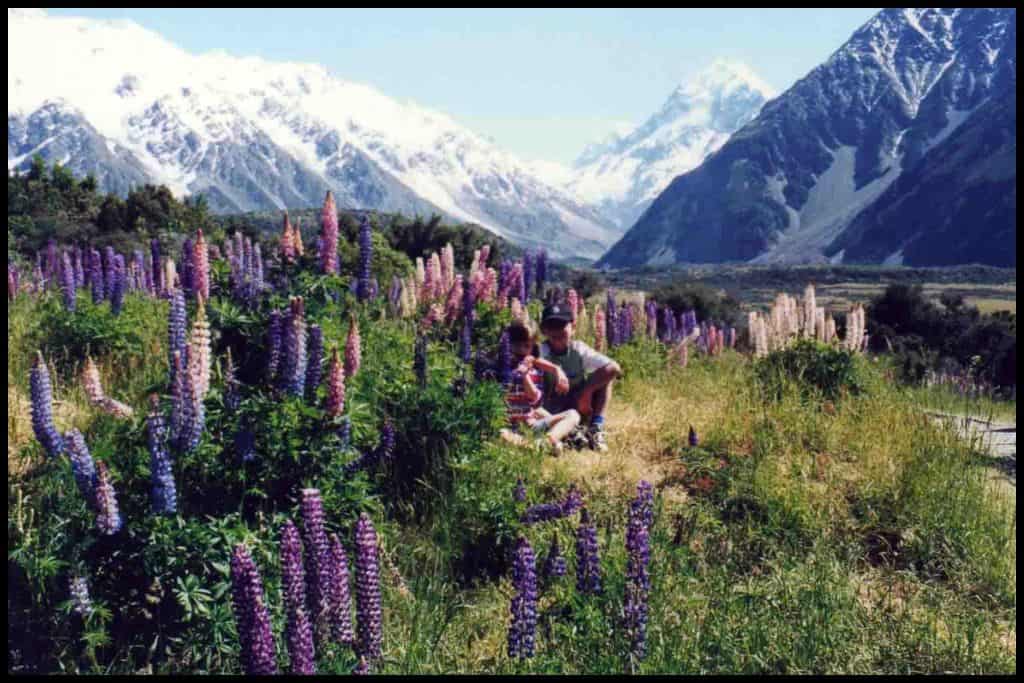
7. Catch a wave
Surf’s up! Summer is an ideal time to go catch a wave – or take a surfing lesson, if you’re new to the sport.
Our best surfing destinations are undoubtedly Raglan, on the West Coast of the North Island in the Waikato region, or further south out on the Taranaki Bight, where we have New Plymouth City and the Surf 45 highway, out on the opposite coast around the East Cape – and particularly in and around Gisborne City, and in Dunedin, one of our more southern cities in the bottom of the South Island.
You’ll also find some good spots in the Bay of Plenty, like Mount Maunganui / Tauranga, on the outskirts of Auckland City, in the western Waitakere Ranges Regional Park, or over on the West Coast of the South Island, in places such as Westport.
It’s an addictive feeling, standing up on the board, and while I’ve had barely any success in New Zealand waters, it is well worth a try for your summer here.
➡️ xx
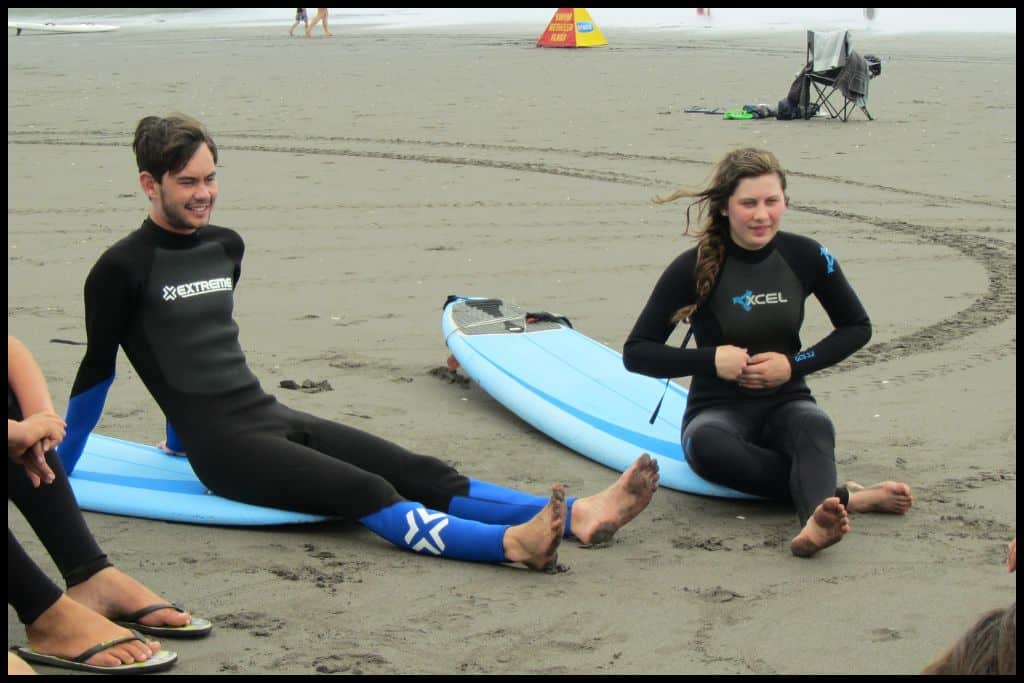
8. Discover our best black sand beaches
Speaking of the Waitakere Ranges Regional Park, in the western part of Auckland City, this area is renowned for not only its wild surf, but its black sand beaches, which people flock from all over to see.
The main ones – and the ones patrolled by lifeguards – are Karekare Beach, famous Piha Beach, Muriwai Beach, and Te Henga Bethells Beach, but there are a few others between these bigger ones, like Anawhata Beach, O’Neills Beach, and Whatipu Beach, the southernmost one in this area.
There are some fantastic walks around and between all these – the bigger, four day, Hillary Trail links them all, but sections are closed so you can’t do them all continuously at the time of writing. The Ranges are suffering from kauri dieback disease and the fungus is being spread by all the foot traffic through the bush so in an effort to protect the lives of our native trees, many tracks have spent quite a few years closed, with some just opening again now, or in the last couple of seasons.
Most tracks will have foot washing stations and it’s really important to scrub your boots upon entry so that you are not spreading the disease.
These beaches are also great for just hanging out on. Whatipu is a good place to collect mussels. Muriwai Beach has a large gannet colony on the cliff top, and Te Henga Bethells Beach has rolling black sanddunes with Lake Wainamu hidden in the middle of them. Bear in mind that black sand heats up quickly under the sun, so much more compared to white sand, and that you will not make it more than a few steps if you do not have shoes on.
I have a post written about these beaches HERE, if you are inspired!
➡️ xx

9. Go berry picking
The recommendations on these seasonal posts are all inspired by seasonal activities – and that automatically means they’re related to nature, to plants, trees, flowers and fruit, a lot of them, because these are things that have seasonal appeal.
Berry picking is a favourite summer activity in my family, and a great one for your summer bucket list. There are so many farms around New Zealand that offer these experiences – I started making a list and it got way too long so I have written a post about it HERE instead!
Strawberries are the most common berry picked and the easiest PYO farms to find. They have a longer season too, October until April in some parts, but November, December, January and February are great months for strawberry picking.
Probably the second most popular berry to PYO is the blueberry, and theres a few farms in each region that offer this. The blueberries also have a long season and can generally be picked all summer long.
Not as many establishments offer raspberry picking, but Good Planet NZ in Auckland and Monte Christo Winery in Central Otago are two such places that have offered this previously. It’s really a January only activity though.
Boysenberries and blackberries are not as common but PYO places do exist and December and January are the time to do this, although you may also get some blackberries in February, too.
Lots of these establishments have onsite cafés and a popular treat in New Zealand is to enjoy a real-fruit icecream – one where they send all the berries through a mixer, mixed with either icecream or yoghurt, and serve you up a fresh cone on the spot. Delicious!
➡️ xx

10. Go SCUBA diving at one of the top dive sites in the world
The Poor Knights Islands in the top of the North Island are one of the top dive sites in the world, and SCUBA divers come from all over to swim in these beautiful waters. The gateway town is Tutukaka, but you’ll already be quite close if y0ur trip includes Whangarei.
Divers will be able to explore the Rikoriko Cave, which is one of the biggest sea caves in the world, and several rocky arches, too.
There’s a wide variety of fish to see, and different parts of the reserve that suit different abilities. Of course, there are dive schools, too, if you are brand new.
➡️ xx

11. Stop at a cellar door for a spot of wine tasting
New Zealand has several great regions where wine is grown. North to South, we have Waiheke Island, part of Auckland City, Hawkes Bay, out on the east coast of the North Island, with the Wairarapa area below that, in the southeastern corner of the North Island, while the South Island has Marlborough at the top, Waipara Valley north of Christchurch City, and Central Otago and Gibbston Valley down further south, closer to Queenstown.
So no matter where you are holidaying, make sure you stop in at a couple of cellar doors for some wine tasting. Summer is a great time to do this as the vineyards tend to be livelier, more popular, and people like to sit outside and enjoy the beautiful vines. Not as many establishments stay open for winter, so take advantage of the warm weather and stop in.
Each of the above regions have lots of different vineyards, and many are connected by cycle trails so that people can cycle from vineyard to vineyard. Gibbston Valley has the Gibbston River wine trail, Waipara Valley has the Waipara Valley Vineyard Trail, Marlborough has the Marlborough Vineyard Trail, the Wairarapa has the Vineyards Ride, and Hawkes Bay has the Wineries Ride.
➡️ xx

12. Spend a day in the orchards picking your own stone fruit
A quintessential summer activity in New Zealand is to pick your own fruit – and there are not only opportunities for berry picking, but stone fruit picking too, particularly in Central Otago, in the south of the South Island. This is a fantastic region for growing fruit, due to the long summers and the winter frosts that result in sweet fruit.
The town of Cromwell is particularly known for its cherries, but surrounding towns are filled with orchards of all kinds – particularly apricots and peaches, nectarines and plums,
I would definitely recommend getting yourself down there in the middle of the summer and spending a day or two out in the orchards, picking. You normally pay for what you have picked afterward, according to weight, but some places might make you pay for an empty bucket instead, which you can then fill.
Great locations for fruit picking are Cromwell, Alexandra and Roxburgh, but there is also an abundance of orchards in between all those places.
➡️ xx

13. Attend one of our many food and wine festivals
New Zealand loves a wine and food festival, and over summer in particular, there are many. A popular one is Toast Martinborough, held in January each year, located in Martinborough, one of the small towns in the Wairarapa district, which is in the bottom right hand corner of the North Island.
In February each year, Marlborough hosts Marlborough Food and Wine Festival, at the top of the South Island, and Cromwell has the Cromwell Food and Wine Festival at the start of January each year.
In February, Twizel, the gateway to Aoraki Mount Cook National Park, has its Twizel Salmon and Wine Festival, and in January, Katikati in the Bay of Plenty hosts the Katikati Avocado and Wine Festival.
These events often include market stalls, food trucks, live entertainment, cooking demonstrations, wine tastings, seminars, and a whole lot of good food and wine. No matter what island you’re spending the summer on, there will be a food and wine festival not too far away.
➡️ xx
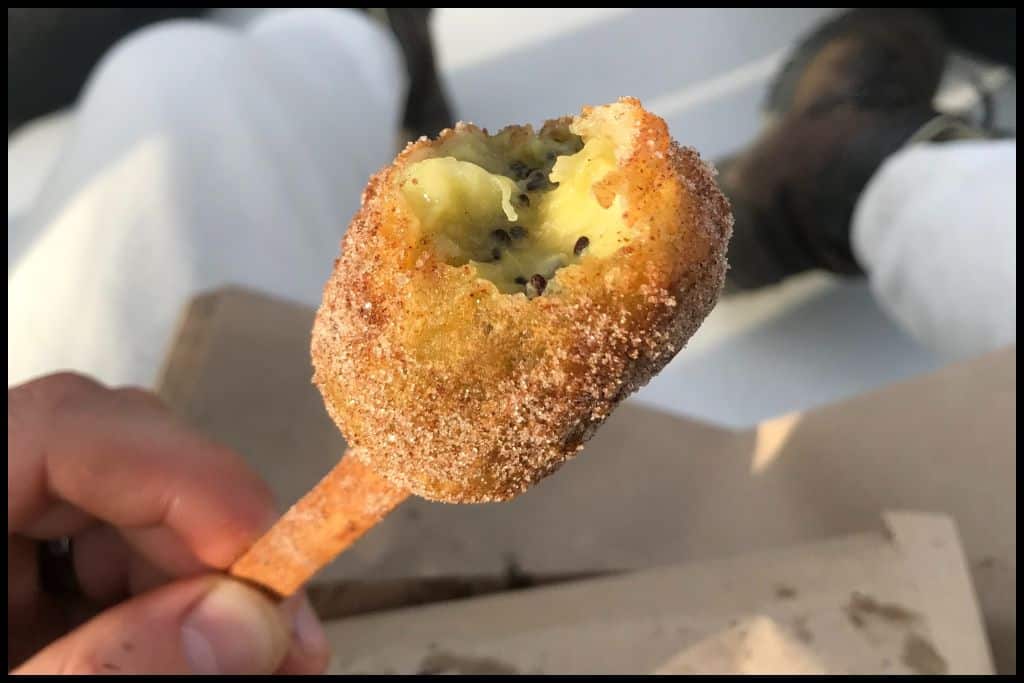
14. Journey down one of our mighty rivers
We have many beautiful rivers in New Zealand and taking to the water is a fantastic activity over the summer months, precisely because the weather is so warm and getting a little wet is okay, pleasant, even!
Many of our river journeys are white water rivers where river guides can take you down the white water rapids by way of raft. Lots of outfitters offer a range of journeys ranging from half a day to multi-day journeys.
If you are after something more sedate, the Whanganui River Journey (one of the 10 Great ‘Walks’ of New Zealand) is quite a calm river and does not require a guide. There are plenty of providers in the area who can sell you a package with gear and a guide, or for just the gear (‘freedom hire’). We went self-guided in 2023 and found it a very easy journey! However, a friend went later in the summer, when the river was lower, and found the paddling much more hard-going. We went right on the cusp of spring and summer so recent rainfall had meant higher river levels and a very cruisy journey down!
I would also be so excited for you if you opted for a white water journey! Key locations where can do this would be Rotorua, Tongariro National Park, out in Hawkes Bay, the Hutt Valley, North Canterbury, on the Four Rivers Plain, in Glacier Country, or in Queenstown.
Key white water rivers to consider journeying down would be the Tongariro River, the Kaituna River, the Mohaka River, the Hutt River, the Clarence River, the Buller River, the Whataroa River, the Matukituki River, Kawarau River or Shotover River.
➡️ xx
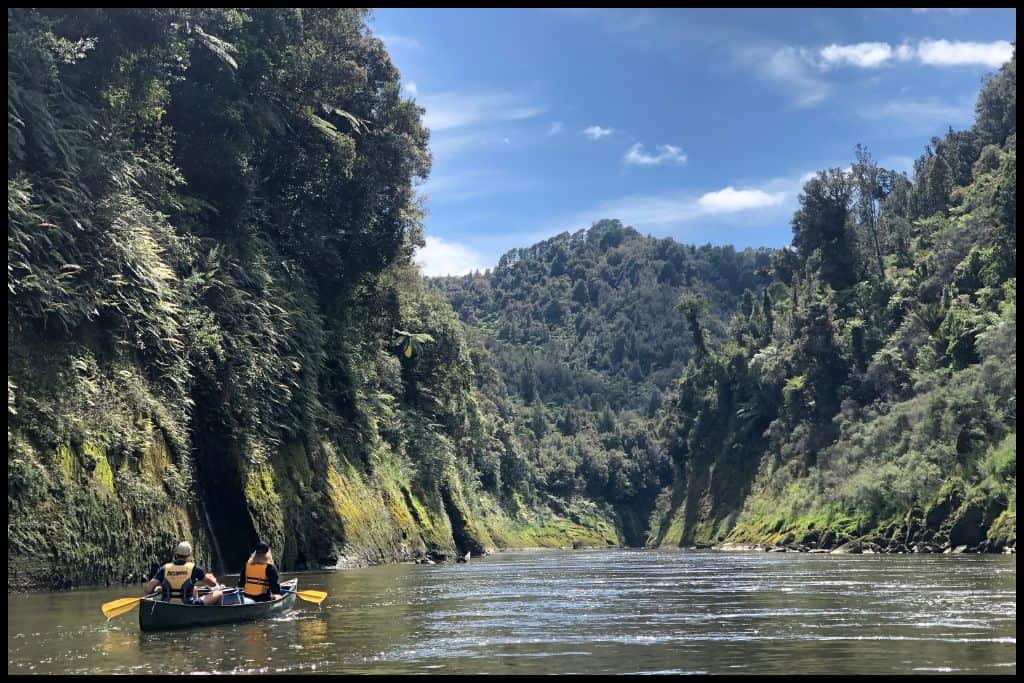
15. Step back into the 1920’s at the Art Deco Festival
Another festival – but something quite unique! The Napier Art Deco Festival is an annual event held in February, in Napier, which is out in Hawkes Bay.
The city has a lot of art deco architecture, as it was rebuilt after a devastating earthquake in the height of the art deco period.
This has served as the inspiration for the festival, which has now been running for over 35 years. Over 50,000 people attended last year! It’s quite a big deal.
The P&O Cruise company even do cruises from Auckland down to Napier especially for the festival, and then back up into the Auckland port again.
The art deco festival spans four days and involves dressing up in 1920s garb! There are parades, air shows, fashion shows, lots of fun vintage events, vintage cars, lots of history, food and drink, music – over 200 different things to do, in fact.
Definitely a highlight on the calendar for anyone in New Zealand over the summer.
➡️ xx
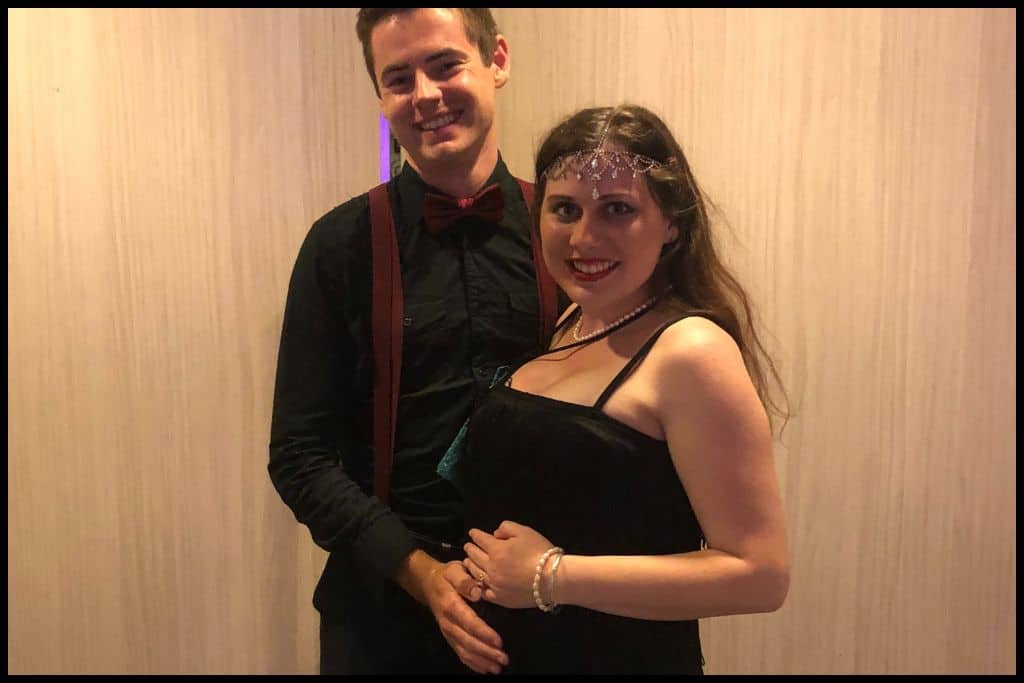
Best Places To Go In New Zealand In Summer
There are so many wonderful destinations for your summer holiday in New Zealand. Each of them offer so much beauty, and so much to do. While winter has its fair share of magic in these destinations, too, I would consider summer to be the best time to visit these spots below.
Here are my recommendations of towns and regions you should consider for your summer holiday itinerary. Each offers something best experienced in the summer months. If you can get to any or all of these, you’ll see some of New Zealand at its best – and some of the reason why summer here is just so blissful.
📍 Northland Region: Bay of Islands & Poor Knights Islands
Northland is an excellent choice of destination for your New Zealand summer. Two sub regions in particular, Bay of Islands, (gateway town of Paihia) and Poor Knights Islands (gateway town of Tutukaka), are especially good choices.
The Bay of Islands is home to 144 islands and lots of operators who can take you out by boat. Even on the mainland, the beaches are pristine. Northland is blessed with almost tropical weather in summer, white sandy beaches, and clear waters.
Poor Knights Islands are home to a world-renowned marine reserve which is world famous for its scuba diving – but is a great snorkelling destination, too.
These are great places to go if you are after an encounter with marine wildlife, a good old beach break, diving, kayaking, or water sports of any kind.
The Far North (Karikari Peninsula) hosts the Northland Food and Wine Festival in December each year, and then you have Kerikeri, Kaikohe and Whangarei with options for berry picking. Rukuwai Farms is a sunflower farm on your way out to Whangarei Heads worth checking out, so Northland really has got it all!
I would probably suggest using Whangarei and/or Paihia as a base to get the most out of your Northland holiday. Here are some places you could stay in Paihia, which is a great spot to be in to explore the Bay of Islands fully:
Budget Option: Haka House Bay of Islands
Haka House, based in Paihia, is the perfect option for the budget traveller wanting to get out into the Bay of Islands. The location is excellent, being across the road from the boat wharf, and the prices are better still. Dorm bed rates drop as low as
$41NZD 🇳🇿 ($24USD 🇺🇸 ), and with all the facilities on site that you could need, this place is worth a second look.
Mid-Range Option: Breakwater Motel
Breakwater Motel is a fantastic mid-range option situated in Paihia, not too far from the town centre (easily walkable), affordable, but still with a touch of luxury. They have a number of studios and suites that you can book, and they’ll help you with any activity bookings that you want to make during your time there. Rates range a bit between $160NZD 🇳🇿 ($95USD 🇺🇸 ) and $185NZD 🇳🇿 ($110USD 🇺🇸 ) per night.
Luxury Option: Tarlton’s Lodge
Tarlton’s Lodge is your go-to for luxury in the town of Paihia. The lodge is an adults-only retreat, commanding wide views over the harbour and bay of islands. The rooms have private decks and private hot tubs, and guests rate the hospitality and serenity of the place very highly. Expect to pay $385NZD 🇳🇿 ($228USD 🇺🇸 ) or thereabouts for each night of luxury there.
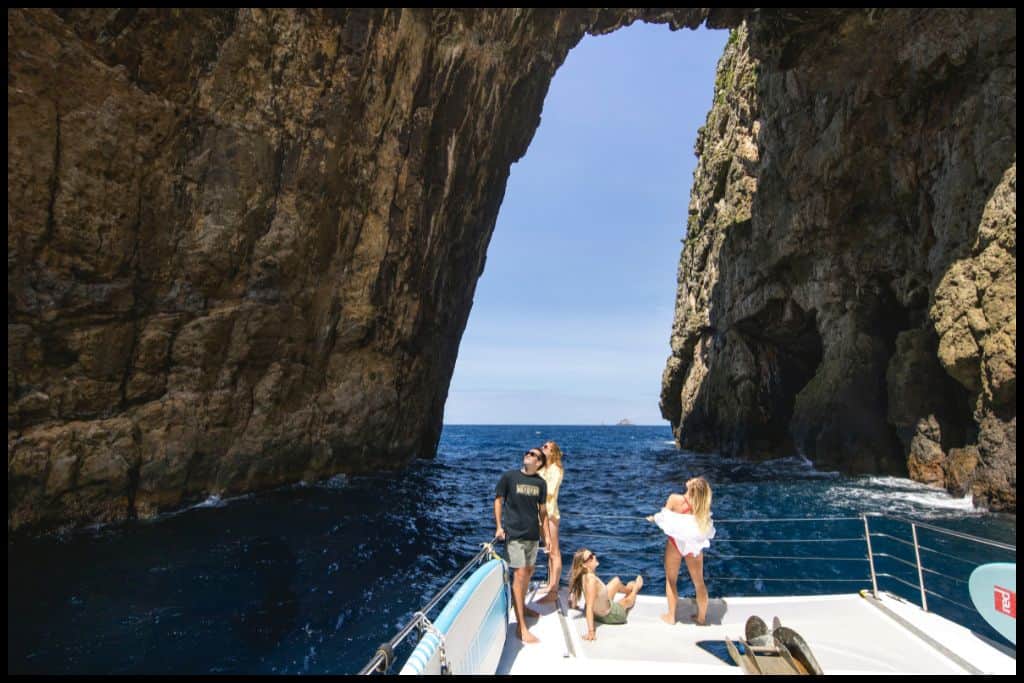
📍 Auckland
Auckland, our most populous city, is actually a great base for a summer holiday.
The west coast, out in the Waitakere Ranges Regional Park, is a treasure trove of black sand beaches, popular amongst day trippers keen to see them, or anyone wanting to get some beach time in. These west coast beaches are also really popular with surfers, and Piha, Muriwai and Te Henga Bethells Beach in particular make for great surfie destinations.
Auckland’s east coast beaches by comparison tend to be white sand and more sedate, great for swimming without all the waves, or kayaking or paddle boarding. Auckland’s Hauraki Gulf is filled with lots of volcanic islands, so there are many island hopping options for the boaties amongst us. Nicknamed the City of Sails, it’s really common place to see yachties and boaties out there on the Gulf in summer.
For marine life, the Goat Island Marine Reserve is the go-to spot for great snorkelling and a huge variety of fish. And I know several people who have had orca whale sightings or dolphin sightings while boating out on the Hauraki Gulf!
Those based in Auckland who are after sunflowers will find them at Franklin Farm, Sunshine Fields, Cedel Downs and can even make the short drive south to Taupiri Sunflower Farm in the Waikato region for their sunflower fix.
CCT Lavender Farm in the south of Auckland and GoodPlanet NZ berry farm in the north of Auckland are both excellent days out with pick your own options – and you’ll find a tonne more places that solely offer strawberry picking, if you’re after something a little more centralised.
Auckland also boasts a really good wine region, out on Waiheke Island in the Hauraki Gulf. An easy forty minute ferry trip from the downtown CBD puts Waiheke Island in reach for all visitors, and opens up access for you to about thirty vineyards, best enjoyed in summer.
Budget Option: Frienz Backpackers Hostel
Stay central in Auckland at Frienz Backpackers Hostel, a fun and comfortable hostel. They have a courtyard and an outdoor area up on the roof, and a range of rooms, from shared to private. Room rates can vary a fair bit but average at about $60NZD 🇳🇿 ($36USD 🇺🇸 ), sometimes costing up to $20NZD 🇳🇿 ($12USD 🇺🇸 ) more, or less.
Mid-Range Option: Quest Carlaw Park
Quest Carlaw Park is a good middle ground for those after comfort and affordability, and even those who are coming in by car and want to take advantage of the onsite parking. A car is a bit of a necessity in Auckland but the CBD itself is no fun to drive in, what with one way roads, detours, roadworks, traffic and low speed limits! Quest is just a little further out (not by much) so still very quick to access downtown, if catching a ferry from one of the main wharves is on your agenda. A night at Quest Carlaw Park will cost you about $140NZD 🇳🇿 ($83USD 🇺🇸 ).
Luxury Option: The Hilton
The Hilton, in downtown Auckland, is your 5 star resting place over the water with views, luxury, comfort and prime location. It has an onsite bar and restaurant, a pool with an underwater viewing window (the hotel sits on top of a wharf) and buffet breakfasts available at an additional cost. Rates vary a lot across different platforms but expect to pay between $250NZD 🇳🇿 ($148USD 🇺🇸 ) and $450NZD 🇳🇿 ($267USD 🇺🇸 ) a night.
📍 The East Cape & Hawkes Bay
The Hawkes Bay region, and the East Cape (the easternmost point of New Zealand) just above it, are two great summer destinations very easily packed into one itinerary, due to their proximity to each other.
This is an area of the country with great beaches, great wine, and great orchards. There are several establishments in the Hawkes Bay where you can pick your own fruit, and there’s an abundance of cellar doors and vineyards where you can stop for some wine tasting.
There are really good surf breaks all the way down this stretch of coastline, and surfers will be spoilt for choice, but may err towards the East Cape itself, or the Mahia Peninsula right underneath it.
Hawkes Bay is somewhat known for whale sightings, and it was in Mahia itself where I had the privilege of swimming with a wild dolphin, Moko, on Christmas day in 2008 (!) although this is not commonplace.
Baxter’s Sunflower Farm, Casa Lavanda and Nevaria Lavender are all beautiful floral spots in the Hawkes Bay, the Mohaka River is the spot of the region to go white water rafting, and Napier, of course, capital of the Hawkes Bay region, is the host of the Art Deco Festival.
Base yourself in Napier to enjoy the best of the region this summer:
Budget Option: Archie’s Bunker
Centrally located in Napier, affordable Archie’s Bunker offered both shared and private rooms, with shared room rates as low as $30NZD 🇳🇿 ($18USD 🇺🇸 ). Transport to and from Hawkes Bay Airport can be arranged with the backpackers and they offer fun events and mixers where you can meet other travellers.
Mid-Range Option: Quality Inn Napier
Quality Inn is great option for the mid-range traveller, with its onsite carparking, great location, free wifi and pool facilities. They have a range of studio options as well as a two bedroom apartment on offer and conference spaces. Expect night at Quality Inn to cost around the $150NZD 🇳🇿 ($89USD 🇺🇸 ) per night mark.
Luxury Option: The Manse Luxury Lodge
The Manse is a historic colonial home, now turned five-star luxury accommodation experience, not too far inland from Napier. It’s rural setting provides amazing views over the hills and vineyards, and guests can enjoy the pool, library, gardens or their own lush suites. A range of activities are offered, and exquisite food and wine. The River View Suite goes for $1550NZD 🇳🇿 ($919USD 🇺🇸 ) per night.
📍 Abel Tasman National Park
Abel Tasman National Park is located at the top of the South Island, with Nelson as the capital of the Tasman region and the main fly-in point for those wanting to access the area from outside the region.
The park is the country’s smallest national park but it is such a gem! The beaches are not white but golden, and the sea is a pristine turquoise – I could not get over how clear the water is when I walked the coastline in 2022.
It is the place to be to engage in a bit of sea kayaking, with lots of operators in the area who can rent you what you need. Reliable ferry services connect all the beaches (the park is predominantly coastal and there are lots and lots of beautiful beaches to pick from).
You may be able to have an encounter with some of our wild seals in the national park, as they are sometimes spotted by kayakers, and you will also want to check this area out if SCUBA diving is a hobby of yours.
Come to Abel Tasman National Park predominantly for the beaches, the swimming, the kayaking, the walking and the golden sands you can spend all afternoon on, if you like.
Budget Option: Kanuka Ridge Abel Tasman Backpackers
Kanuka Ridge Abel Tasman Backpackers is located at Marahau, one of the park entrances. Many of their rooms are private for your group but share facilities (kitchen, dining and bathrooms), while other rooms have their own ensuites.There’s a real range, and they go for between $16NZD 🇳🇿 ($10USD 🇺🇸 ) and $55NZD 🇳🇿 ($32USD 🇺🇸 ) per night.
Mid-Range Option: Kimi Ora Eco Resort
Located nearest Kaiteriteri Beach in the park, Kimi Ora Eco Resort is a great middle ground for the traveller who wants a bit more comfort than a backpackers, but still with affordability. Their rooms have views of the sea and it’s not far to walk down to the beach. They have pools, hot tubs and a sauna, bicycles and a games room, as well as an included buffet breakfast. At around $250NZD 🇳🇿 ($148USD 🇺🇸 ) to $300NZD 🇳🇿 ($178USD 🇺🇸 ) per night, this place is a steal.
Luxury Option: Awaroa Lodge
Your luxury option in the park is the beautiful Awaroa Lodge! It’s so secluded and private you must arrive by boat (into the Awaroa Estuary) or along the coastal track on foot. They have a restaurant with a conservatory, and a garden bar and pizzeria. Note that signal and wi-fi is limited here but for an off-grid experience, you can’t beat it. They have an on-site spa and library, friendly helpful staff and an absolutely unbeatable location. A night at the lodge can vary quite a bit with price but anywhere upward of $550NZD 🇳🇿 ($326USD 🇺🇸 ) to about $900NZD 🇳🇿 ($533USD 🇺🇸 ) per night is the expected.
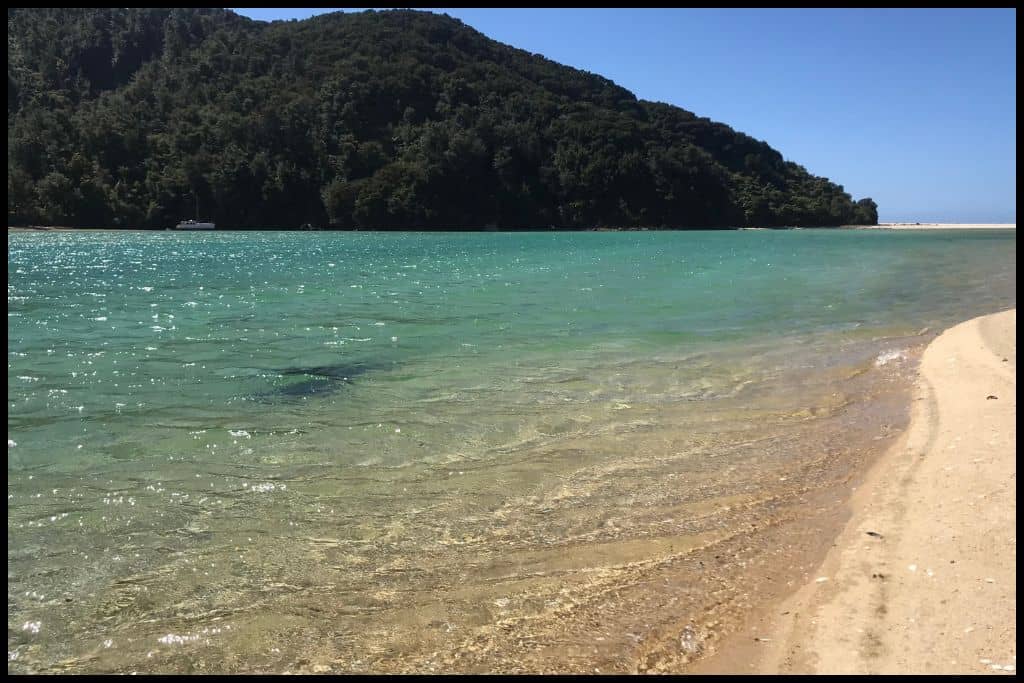
📍 Otago Region: Central Otago & Queenstown-Lakes Districts
Otago is amazing in the summer and picking where to base yourself can be hard! I would struggle to choose between Central Otago (Alexandra, Cromwell, Clyde, and the like), and the Queenstown-Lakes District (which predominantly refers to Lake Hawea, Lake Wakatipu and Lake Wanaka, which represent towns Queenstown and Wanaka).
Central Otago right through to Queenstown is one amazing route for wine enthusiasts. I’m a local myself, now, and have already counted over one hundred vineyards along this stretch, so definitely stop at a cellar door and engage in some wine tasting.
A particularly popular way to see multiple vineyards is to cycle between them, and I am not sure there is any better region in the country for cycling than Otago, with its extensive network of cycle trails. The Queenstown Trail alone is comprised of several smaller trails that link up, and most of the Central Otago trails are starting to be connected, too, so it won’t be long before you can cycle uninterrupted across the whole region!
There’s at least three lavender farms across this area, beautiful lakeside beaches, an an absolute abundance of fruit picking opportunities in the numerous orchards across Central. Cromwell hosts the Cromwell Food and Wine Festival each summer, and the Kawarau and Shotover Rivers offer incredible river journeys – whether that be by white water raft or jetboat, (or even white water sled)!
I would recommend Cromwell as a base for your holiday, perfectly, centrally, located between Queenstown, Wanaka, and the rest of Central Otago, with much to offer.
Budget Option: River Rock Estate
While there are no hostels operating in Cromwell at the moment, River Rock Estate does offer self contained campervan parks for an affordable rate of $60NZD 🇳🇿 ($36USD 🇺🇸 ) per night. Hot pools and a sauna are are on site for an additional charge, and wine tasting is offered as a paid activity, too. The location is beautiful and right in town, so a great option for the budget traveller who has a camper.
Mid-Range Option: Lake Dunstan Motel
For those driving through the region, a motor inn is a great mid range accommodation option. Lake Dunstan’s Motel rooms have kitchens, televisions, and great settings. They are centrally located for good access to all the activities in the surrounding areas. They have a courtyard and barbecue for guest use and are a great option. Their studios go for $180NZD 🇳🇿 ($107USD 🇺🇸 ) per night.
Luxury Option: Marsden Lake Resort
This luxury stop just a few minutes out of Cromwell comprises luxury boatsheds as the accommodation – overwater villas – in a beautiful lakeside, mountainous setting. They have range of studios and rooms, including one with a private hot tub, which goes for $420NZD 🇳🇿 ($249USD 🇺🇸 ) per night, or thereabouts.

Visiting New Zealand: FAQs
There you have it, my recommendations for your ultimate summer in New Zealand. Now, for some frequently asked questions:
Is New Zealand humid in the summer?
New Zealand can be quite humid, especially compared to the likes of Australia, but is not quite on the same level of humidity as South East Asia, or the Pacific Islands, for example.
Up north they enjoy a more tropical summer than in other parts, and Auckland in particular can get quite muggy and can still endure a bit of summer rain. Down in Canterbury and Otago regions it is much drier, so head south if you are trying to avoid any humidity.
What should you wear during summer in New Zealand?
A good wardrobe for a New Zealand summer will have a bit of everything – a light showerproof jacket in case of rain, or covered shoes for any walking or cycling, but open shoes, too, like flip-flops (jandals), or sandals.
It is culturally acceptable to be barefoot quite a lot of the time, including for any quick dashes into the supermarket or into the dairy for an icecream – much to the surprise of other cultures, I think!
Your summer wardrobe should largely comprise of shorts and short sleeved tops, or singlets, as the days are warm, and, due to the quick burn time under the sun here, hats, suncream and sunglasses are vital.
How long are the New Zealand summer holidays?
New Zealand primary schools break for six weeks from Christmas until the first week of February, when we have a national long weekend and public holiday on February 6 (Waitangi Day).
New Zealand secondary school students tend to finish earlier, with exams occurring in November and students assuming school holidays when their personal exam dates are done.
New Zealand universities don’t pick up until March, so students tend to get all of February off, as well!
For everyone else, many workplaces shut and give annual leave to workers from the week of Christmas through until the end of the first week of January. The last week of December and first week of January are the busiest for holiday locations, nationwide.
Does New Zealand celebrate Christmas in the summer?
Yes! Christmas, December 25, is three weeks into the New Zealand summer, and generally the point at which schools and workplaces break up for at least the Christmas and New Year period. A Christmas in summer is a foreign concept to anyone used to a Northern Hemisphere Christmas: snow, mulled wine, stockings over fireplaces, and cosy feasts. Christmas in New Zealand is often time at the beach, food done over a barbecue, an afternoon swim, cool cocktails, or hanging out in the sun on the deck!
New Year is a popular getaway time for most people due to the warm weather, and festivals pop up all over the country. Our roads get busier, with people travelling inter-regionally, and the prices of domestic flights will typically be up throughout the Christmas and New Year periods, as people travel to and from family.
This is New Zealand in the summer, and everything that will make your summer trip memorable! Some of our landscapes and experiences are simply like nothing else, and have to be experienced for oneself.
Whether you pick and choose from the options above, or decide to do them all (which is so doable!), enjoy the planning and .. see you out there!

